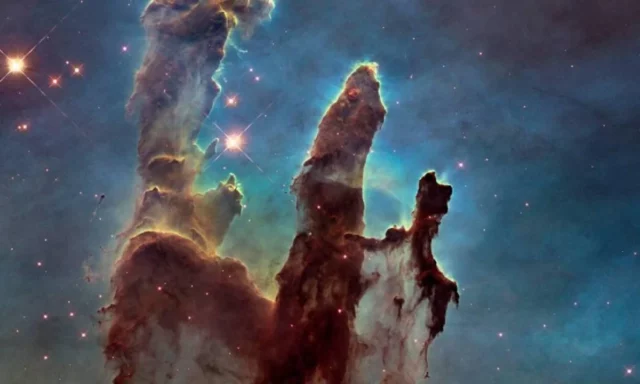The James Webb Space Telescope captured the iconic “Pillars of Creation” -huge structures of gas and dust teeming with stars- and the image is as majestic as you’d expect, NASA said on Wednesday. The “Pillars of Creation” are located 6,500 light-years from Earth, in the Eagle Nebula of the terrestrial galaxy, the Milky Way.
The twinkling of thousands of stars illuminates the James Webb Telescope’s first shot of these gigantic brown and orange columns rising from the midst of the cosmos. At the ends of several pillars are bright red patches, resembling lava. “These are ejections from stars that are still forming”, only a few hundred thousand years old, the US space agency said in a statement. These “young stars periodically launch supersonic jets that collide with clouds of material, like these thick pillars”, he explained.
The “Pillars of Creation” became famous thanks to the Hubble Space Telescope, which first captured them in 1995 and then in 2014. But thanks to the infrared capabilities of the James Webb, the world’s most powerful and modern telescope launched into space less than a year ago, it can be seen through the opacity of the pillars, revealing the formation of many new stars.

“By popular demand, we had to do the Pillars of Creation” with James Webb, Klaus Pontoppidan, science program manager for the Space Telescope Science Institute (STScI), which operates Webb from Baltimore, said on Twitter on Wednesday. “There are so many stars!”, he added. NASA astrophysicist Amber Straughn summed it up in a tweet: “The universe is beautiful!” The image, which covers an area of around 8 light-years, was taken by Webb’s NIRCam imager, which captures near-infrared wavelengths invisible to the human eye. The colors of the image were “translated” into visible light.
According to NASA, the new image “will help researchers revamp their models of star formation by identifying much more accurate counts of newly formed stars, along with the amounts of gas and dust in the region”. In operation since last July, the James Webb is making its observations 1.5 million kilometers from Earth.
One of the main purposes of this US$10 billion telescope is to study the life cycle of stars. Another main line of research is the study of exoplanets, that is, planets outside the Earth’s solar system.


